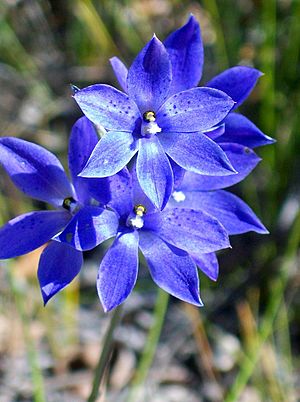Spotted sun orchid facts for kids
Quick facts for kids Spotted sun orchid |
|
|---|---|
 |
|
| Thelymitra ixioides in Ku-ring-gai Chase National Park | |
| Scientific classification | |
| Genus: |
Thelymitra
|
| Species: |
ixioides
|
| Synonyms | |
The Thelymitra ixioides, also known as the spotted sun orchid or dotted sun orchid, is a beautiful type of orchid. It grows naturally in southern and eastern Australia, and also in New Zealand. This orchid has one long, thin, dark green leaf. It can grow up to ten flowers. These flowers come in many colors, often blue or purple. They usually have small, dark blue spots. The spotted sun orchid can look a bit different from one plant to another. It is similar to another orchid called T. juncifolia, but its flowers are usually bigger.
Contents
What Does the Spotted Sun Orchid Look Like?
The spotted sun orchid is a tuberous plant. This means it has a swollen underground stem that stores food. It is also a perennial herb. This means it lives for more than two years and has soft, green stems. Each plant has one dark green leaf. This leaf can be thin like a thread or shaped like a spear. It is about 200–300 mm (8–10 in) long and 10–15 mm (0.4–0.6 in) wide. The bottom of the leaf is often purplish.
Its Flowers
The plant grows a flowering stem that is about 300–600 mm (10–20 in) tall. On this stem, you can find between two and ten flowers. These flowers are usually blue or purple. They have small, darker blue spots. Each flower is about 30–40 mm (1–2 in) wide. Sometimes, the flowers can be pink, green, or white. They might even not have any spots at all!
The flower parts called sepals and petals are about 15–20 mm (0.6–0.8 in) long and 9–12 mm (0.4–0.5 in) wide. Inside the flower, there is a part called the column. It is white or blue, about 4–6 mm (0.16–0.24 in) long and 3 mm (0.1 in) wide. The top part of the anther (which holds pollen) is yellow. It has a dark blue band on its back. It also has many small, finger-like glands with yellow or orange tips. The side parts of the column have thick, brush-like tufts of white, pink, or bluish hairs.
Reproduction
Sometimes, these orchids can self-pollinate. This means they can make seeds using their own pollen. But more often, insects help them pollinate. This happens when insects carry pollen from one flower to another. The spotted sun orchid usually blooms from September to December.
How Did It Get Its Name?
The Thelymitra ixioides was first officially described in 1805. A Swedish botanist named Olof Swartz gave it its scientific name. He published his description in a science journal called Neues Journal für die Botanik.
The second part of its name, ixioides, comes from a special reason. It means the orchid looks similar to plants in the Ixia group. The ending -oides is a Latin suffix that means "likeness" or "resembling." So, ixioides means "looks like an Ixia."
Where Does the Spotted Sun Orchid Grow?
The spotted sun orchid is very common in Australia. It is found in many different places there. It is a bit less common in New Zealand. You can find it growing in many types of areas. It likes heathlands (open areas with small shrubs) and forests the most.
In Australia, it grows in the Darling Downs area of Queensland. It is also found along the coast and in the tablelands of New South Wales and the Australian Capital Territory. You can see it in most parts of Victoria, in southeastern South Australia, and in Tasmania. In New Zealand, it grows on both the North and South Islands.
Related pages
- Thelymitra nervosa, another type of orchid found only in New Zealand. It is also sometimes called the spotted sun orchid.
See also
 In Spanish: Thelymitra ixioides para niños
In Spanish: Thelymitra ixioides para niños

